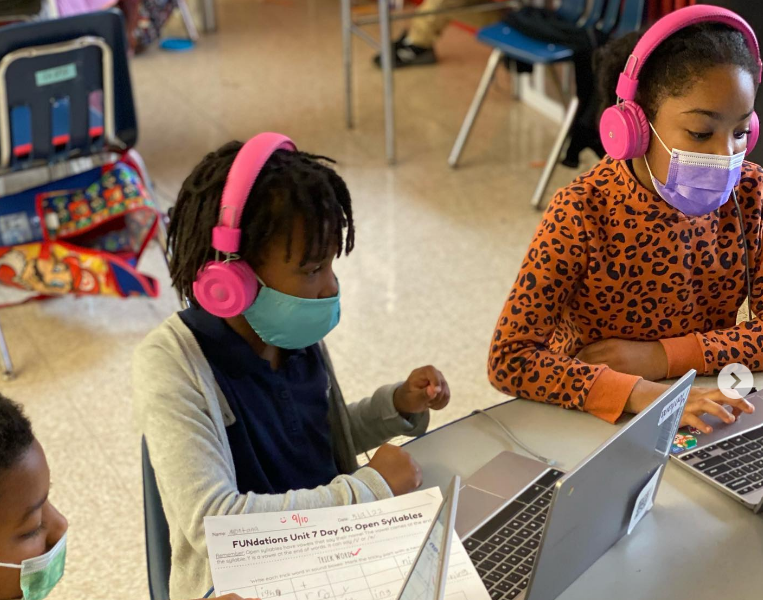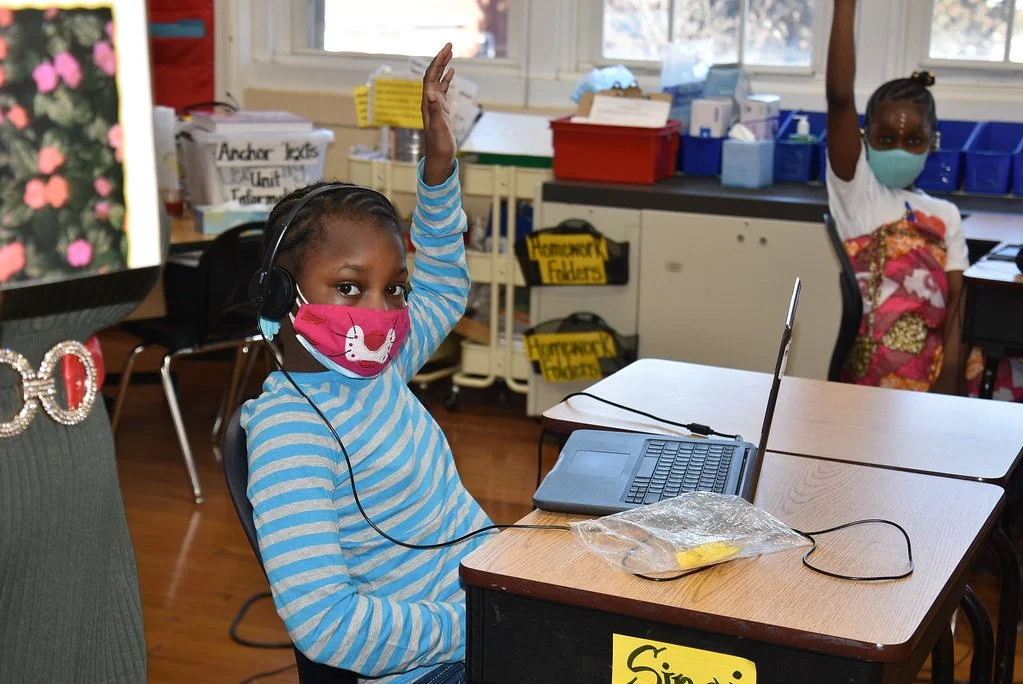
EK12 BLOG WITH ANALYSIS & ANNOUNCEMENTS
Our analysis of local and national educational data and policy trends.
DC Recognized as Bright Spot on National Education Recovery Scorecard
The latest update of the Education Recovery Scorecard, which tracks academic progress in school districts across the country, has identified DC as a state and DC Public Schools (DCPS) as standouts making significant strides in student achievement and pandemic recovery.
DC’s Progress on the 2024 Nation’s Report Card
Often referred to as the Nation's Report Card, NAEP assesses student proficiency in math and reading in grades 4 and 8 every other year. This year's findings paint a concerning picture of post-pandemic academic recovery in the United States and remarkably consistent progress in DC when compared to the nation.
Why Collaboration is Key in Education
When educators and community partners collaborate effectively, they create a foundation of trust and shared responsibility that directly impacts student outcomes. Decades of research highlight that strong ties between educators, families, and community members lead to improvements in student attendance, grades, and test scores.
How to Assess Your Staff’s Data Literacy Levels and Why Data Literacy Matters in Schools
Schools where students exceed expectations and are on track to close longstanding performance gaps, such as those in our 2023 Bold Performance Schools Report, turn data into action weekly that drives instruction. This blog post describes the practical steps Bold Performance schools take to become data-driven and exceed expectations, and how can EK12 help your school endeavor to become a Bold school
Tracking DC’s Education Recovery: What to Expect from The Nation’s Report Card 2024
As we await the release of the 2024 Nation’s Report Card in Mathematics and Reading for grades 4 and 8, now scheduled for early 2025, the question of how DC is recovering from pandemic-related learning losses remains critical.
Why the Amount of Instructional Time Matters: Maximizing Learning for Student Success
An international randomized control trial in Denmark demonstrated positive student outcomes for adding time to the typical school week, but the true return on investment depended on access to school leader and teacher training to make the best use of that time. In short, researchers found that details matter, and a well-structured strategy with implementation support is necessary to maximize the effectiveness of instructional time.
A Closer Look at DC’s CAPE Scores in the Context of Bold Goals
Performance on the 2024 DC CAPE assessment shows nominal changes in performance, with a 0.7 percentage point increase in math from 2023 and a 0.3 percentage point rise in reading. This apparent stagnation might lead to the perception that our system and teacher were unable to improve student outcomes. However, a more detailed analysis of the data and impact of the pandemic’s abrupt shift to virtual learning reveals a different story that underscores the importance of setting and pursuing bold educational goals for all students.
Why Audacious Goals for Bold Improvement are More Important Than Ever
In the quest to improve educational outcomes, peer-reviewed science and our Bold Schools' experiences point to a powerful formula for success: setting bold educational goals for students, paired with just-in-time, evidence-based supports. The research is clear—when we combine high expectations and smart goals ideas for students with the right support, they can accomplish almost anything we ask of them.
DC Student Achievement Nominally Improves
Today, the DC Office of the State Superintendent of Education (OSSE) released results from the 2024 state assessment in math and English language arts (ELA). While the test has a new name, CAPE, the structure and scoring of the assessment was very similar to the previous PARCC test. The results are a bit disappointing, but covid’s impact was substantial and requires a proportional commitment and response. DC is not alone as achievement is largely stagnant locally and across the U.S.
Chronic Absenteeism is Declining but Remains Above Pre-Pandemic Levels
Since our last update on chronic absenteeism in D.C., shared in our 2022 blog, there has been some encouraging progress. However, even with the progress we’re seeing, absenteeism continues to affect a significant portion of students, with current levels still higher than before the pandemic.
2023 DC PARCC Results: A Step Forward, But How Big and Equitable?
The 2023 District of Columbia state student assessment results in math and English Language Arts (ELA) are out, and they bring both cause for celebration and pause for reflection. While progress has been made since pandemic lows, we still have ground to cover before our students demonstrate achievement at levels similar to the pre-pandemic high of 2019. We focus this blog post on the PARCC test results, a rigorous assessment with items that require students to defend their answers and prove their knowledge on more than just simple multiple-choice questions.
Findings and Recs from Spring ThriveK12 Surveys
This blog post focuses on a select sample of ThriveK12 wellbeing survey data of upper elementary students from 7 schools, middle schoolers from 6 schools, and educators from 7 public charter schools across the District. These schools have been continuous users of the ThriveK12 wellbeing surveys since fall 2020 and provided us with student fall-to-spring growth and attendance data from this year to identify additional correlations.
DC Student Wellbeing Declined This Fall
Student wellbeing index scores from a sample of DC public charter school students dropped this fall, to levels similarly seen in the spring of 2020-21, the second semester of the pandemic’s full virtual year. Panorama index scores for DCPS students also declined during the first semester. This data raises concerns about the holistic wellbeing of students across the DC school system and how quickly students may recover academically and social-emotionally.
Chronic Absenteeism is Up. Bright Spot Schools Use These 6 Strategies.
Chronic absenteeism is on the rise since the onset of the COVID-19 pandemic. This blog post discusses our DC sample’s attendance data and six common themes we heard from teams at two bright spot schools.
DC Must Act to Support Our Most Vulnerable Students
DC’s most vulnerable students have been disparately harmed social-emotionally and academically during the pandemic. We provide an update based on winter 2022 data and ask Council to prioritize an equitable, holistic recovery.
DC’s Undercount of Students Designated At-Risk
While the District has experienced ongoing gentrification, we find one key contributing factor to the decline in the total number of students designated as at-risk is the minimum wage increase. This (rather lengthy) post examines the relationship between District population shifts, minimum wage hikes, the number of students who are designated as at-risk, and the likely undercount of students living in households that can benefit from the additional academic and social-emotional resources that the “at-risk weight” was designed to equitably fund.
Goals and Recs for a Strongest Year Yet
This morning, a coalition of local education support and advocacy organizations formally launches a new campaign to ensure the 2021-22 school year is our Strongest Year Yet. This blog post is a summary of why EmpowerK12 believes in the coalition’s mission and how an equity-centric, continuous improvement-oriented approach can help us exceed ambitious goals we must set for a quick recovery.
More Instructional Time Matters
Among the broad-based academic support recommendations in the research is maximizing the amount of instructional time. Just how important is “maximizing instruction time” when it comes to academic outcomes, and what are ways to obtain more time? We analyze both in this blog post.
Supplemental COVID Slide Report Data
This morning, EmpowerK12 released a report on COVID-19’s Impact on Student Achievement and Academic Growth in DC. We received more than 30,000 students' fall baseline assessment data from DC Public Schools and charter schools across the city to estimate the pandemic's impact on student achievement. This blog post contains additional analyses related to the report, including thorough statistical significance testing of key data points from the report and cuts of the data that fell outside the report’s focus on grades K-10 math and reading.
Influence of Demographic Factors on STAR Scores by Framework
Obligatory warning: This blog post is written for the eduData wonk audience. We examine in-depth the relationship between demographic factors and STAR scores. The post is super heavy on statistics and data science.





















